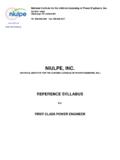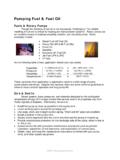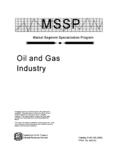Transcription of G-92 Supervision of High-Pressure Natural Gas …
1 FIRE DEPARTMENT CITY OF NEW YORK. STUDY MATERIAL. FOR THE examination FOR. CERTIFICATE OF FITNESS. FOR. G-92. Supervision of High-Pressure Natural Gas fired microturbine Systems 1/15/2008. INSIDE THIS BOOKLET YOU WILL FIND THE FOLLOWING: NOTICE OF examination (NOE). STUDY MATERIAL. 10/2007 New York City Fire Department - All rights reserved . NOTICE OF examination FOR. title : examination for the Certificate of Fitness for Supervision of High-Pressure Natural Gas fired microturbine Systems (G-92). Date of Test: Written tests are conducted Monday through Friday (except legal holidays). 9:00 AM to 2:30 PM. QUALIFICATION REQUIREMENTS. 1. Applicants must be at least 18 years of age. 2. Applicants must have a reasonable understanding of the English language. 3. Applicants must present a letter of recommendation from his/her employer. The letter must be on official letterhead and must state the applicant's full name, character, physical condition, experience, address of premises where applicant will be employed, and the model and type of High-Pressure Natural gas fired microturbine system(s) installed.
2 4. Applicants must present two (2) forms of satisfactory identification , driver's license and passport picture ID. 5. Applicants must submit written evidence of microturbine manufacturer's training in the specific equipment operation and safety procedures for the equipment installed at the COF applicants' work place(s). APPLICATION INFORMATION. Application Fees: $ for originals and $ for renewals. The fee may be paid in cash, money order, or personal check payable to New York City Fire Department. The $ fee must be payable by all applicants prior to taking the Certificate of Fitness test. Application forms are available at the Public Certification Unit, 9 MetroTech Center, 1st floor, Brooklyn, NY 11201. TEST INFORMATION. Test: The test will be of the written, multiple choice type. A passing score of at least 70% is required in order to secure a Certificate of Fitness.
3 Call (718) 999-1986 for additional information and forms. 11/2007 New York City Fire Department All rights reserved 2. ABOUT THE STUDY MATERIAL. The study material will help the applicant prepare for the written examination for the Certificate of Fitness (G-92) for Supervision of High-Pressure Natural gas fired microturbine systems. This study material does not contain all the information you need to know to work with Natural gas and High-Pressure Natural gas fired microturbine systems. It is your responsibility to become familiar with all applicable rules and regulations of the City of New York, even if they are not covered in this study material. ABOUT THE WRITTEN TEST. You must pass a multiple choice test to qualify for the Certificate of Fitness. A score of 70% correct is required in order to pass the multiple choice test. All questions on the multiple choice test have four answer options.
4 Only one answer option is correct for each question. If you do not answer a question, or if you mark more than one option, your answer will be scored as incorrect. Read each question carefully before marking your answer. There is no penalty for guessing on the multiple choice test. Sample Questions 1. The first President of the United States was: (A) Bill Clinton. (B) Abraham Lincoln. (C) George Washington. (D) Ronald Reagan. The correct answer is C . You would press C on your touch-screen monitor. 2. The capital of New York State is: (A) Albany. (B) Washington (C) New York City. (D) Buffalo. The correct answer is A . You would press A on your touch-screen monitor. 3. Natural GAS. Natural gas is a gaseous fossil fuel consisting primarily of methane but includes significant quantities of ethane, butane, propane, carbon dioxide, nitrogen, helium, and hydrogen sulfide.
5 Nitrogen, helium, carbon dioxide, and trace amounts of hydrogen sulfide, water, and odorants are also present in trace amounts. Natural gas is often informally referred to as simply gas , especially when compared to other energy sources such as petroleum product. Before Natural gas can be used as a fuel it must undergo extensive processing to remove almost all materials other than methane. The methane content can range from 87% to 96% with ethane, propane and other hydrocarbon gases making up the remainder. Due to the large methane content in Natural gas, its properties are very similar. It is assumed to behave as methane. Processed Natural gas is tasteless and odorless. However, before gas is distributed to end- users, it is odorized by adding small amounts of odorants (mixtures of t-butyl mercaptan, isopropyl mercaptan, tetrahydrothiophene, dimethyl sulfide and other sulfur compounds), to assist in leak detection.
6 Breathing Natural gas in trace amounts is harmless, however, Natural gas is a simple asphyxiant and can kill if it displaces air to the point where the oxygen content will not support life. Natural gas is a flammable gas. It can be hazardous to life and property by explosion. Natural gas is lighter than air, due to its specific gravity of which is lower than that of air ( ), Natural gas rises and tends to escape into the atmosphere. However, when Natural gas is confined, such as within a building or other enclosed space, gas concentrations can reach explosive mixtures and, if ignited, result in blasts that could level and destroy buildings. Methane has a lower explosive limit of 5% in air, and an upper explosive limit of 15%. The lower and upper explosive limits are sometimes referred as lower flammable limit and upper flammable limit. Another important characteristic for Natural gas is the autoignition or ignition temperature.
7 Natural gas autoignition temperature in air is 9980F, or 5370C, and represents the temperature at which it can self-ignite without any obvious source of ignition, such as a spark or flame. ANY Natural GAS LEAK SHALL BE REGARDED AS A SERIOUS. HAZARD THAT REQUIRES IMMEDIATE RESPONSE! 4. INTRODUCTION. Microturbines are a relatively new generation technology being used for stationary energy generation applications. They can be used in electricity-only generation, or to produce both heat and electricity, referred to as Synchronous heat and power, or CHP. Microturbines offer several potential advantages compared to other technologies for small-scale power generation, including: a small number of moving parts, compact size, lightweight, greater efficiency, lower emissions, lower electricity costs, and opportunities to utilize waste fuels. Because of their small size, relatively low capital costs, expected low operations and maintenance costs, and automatic electronic control, microturbines are expected to capture a significant share of the market.
8 In addition, microturbines offer an efficient and clean solution to direct mechanical drive markets such as compression and air conditioning. Turbine and Air Intake Generator Filter Power External Gas Converter Compressor Box 5. Microturbines are small combustion turbines approximately the size of a refrigerator with outputs of 25 kW to 500 kW. They evolved from automotive and truck turbochargers, auxiliary power units for airplanes into highly sophisticated and complex equipment. Most microturbines are comprised of a compressor, combustor, turbine, alternator, recuperator (a device that captures waste heat to improve the efficiency), and electric generator. The construction complexity of microturbine systems varies based on output and efficiency characteristics. microturbine systems can be divided into two general classes: Unrecuperated (or simple cycle) microturbines In a simple cycle, or unrecuperated, turbine, compressed air is mixed with fuel and burned under constant pressure conditions.
9 The resulting hot gas is allowed to expand through a turbine to perform work. Simple cycle microturbines have lower efficiencies at around 15%, and provide more heat available for cogeneration applications than recuperated units. Recuperated microturbines Recuperated units use a sheet-metal heat exchanger that recovers some of the heat from an exhaust stream and transfers it to the incoming air stream, boosting the temperature of the air stream supplied to the combustor. Further exhaust heat recovery can be used in a cogeneration configuration. The fuel-energy-to- electrical-conversion efficiencies are in the range of 20% to 30%. In addition, recuperated units can produce 30% to 40% fuel savings from preheating. microturbine systems' efficiency generally decreases at elevated ambient temperatures. The microturbine systems are air cooled and some designs use air bearings, thereby eliminating both water and oil cooling systems used by reciprocating engines.
10 Microturbines operate on either oil-lubricated or air bearings, which support the shaft(s). 6. Oil-lubricated bearings are mechanical bearings and come in three main types - high -speed metal roller, floating sleeve, and ceramic surface. The ceramic surface provides the longest life, operating temperature, and lubricant flow. Oil-lubricated bearings require an oil pump, oil filtering system, and liquid cooling. Air bearings do not require any oil or oil pump. Air bearings permit high speed operations while operating with very low vibration levels. Air bearings may lengthen microturbine startup time. GAS TURBINE PROCESS DESCRIPTION. A gas turbine is an internal combustion engine that operates with rotary rather than reciprocating motion. Gas turbines are essentially composed of three major components: compressor, combustor, and power turbine. In the compressor section, ambient air is drawn in and compressed from the ambient pressure .

















